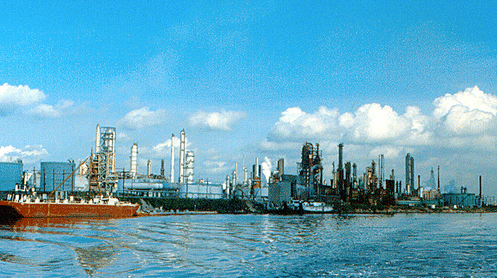‘Energy sufficiency’ for the U.S. in reach as American oil companies consider exports
Crude oil in the United States, often destined for refineries like this one in Houston, may now find its way to Canada instead. (Photo by Roger Wollstadt.)
The search for energy independence has been a central issue for the presidential candidates.
But six major oil companies recently applied for permits to begin exporting U.S. crude oil abroad, starting with sending some of North Dakota’s light sweet crude to Canada, where refiners will pay a higher price. If permission is granted, it would mark the first time in decades that significant amounts of U.S. energy is sent abroad.
Economist Joe Stanislaw, a senior adviser to Deloitte, described the transformation as both exciting and challenging.
“There’s a different mindset in the world of energy today than there was five years ago or 10 years ago,” he said. “The United States is producing more and more oil and more and more natural gas. We’re going from a mindset of scarcity to, not surplus, but to real supply potential in the United States.”
Stanislaw described it as a tectonic shift in the North American energy market — to the point where North America could be energy independent soon, and the United States could be as well in the next 10 to 15 years.
“This is like an earthquake in the mindset of the global energy community and the U.S. energy community,” he said.
The shift comes from several factors, including declining U.S. consumption and new technology that allow energy companies to extra oil and gas from sources that had previously been deemed to tough or too expensive — but that’s all changed. Horizontal drilling, fracking, together they’ve changed the game, Stanislaw said. He attributes these changes to “crazy technology entrepreneurs.”
“These are the people who owned that acreage with those mineral rights and said: ‘I have an asset and I have no way of getting it out,’” he said. “These people worked on this to produce this technology, and it was small — they were the smaller companies … Some of the small oil folks … did this and the big guys bought into it.”
All that’s brought these energy companies to the point where they’re ready to ship some crude oil to Canada — something that’s happened before, but never with great volume. But exporting comes with very specific criteria. Exporters have to show economic and technical reasons why they can’t use it themselves, and they have to be able to stop exporting at a moment’s notice.
And while it’s headed to Canada today, Stanislaw said the oil could go in any number of directions in the future.
“It can go to different parts of South America, it could go to Europe, definitely it could go to China. You actually have people discussing port facilities on the West Coast primarily in Canada, to ship Canadian crude, which they can export obviously, toward Asia,” he said.
Fundamentally, Stanislaw said, American oil companies have oil that’s “stranded,” oil they can’t get the proper price for because of where it is and what the local market is like. So, in an effort to turn that around, they’re looking abroad. Canada, Standislaw said, is just the first toe in the water.
For all the talk about energy independence, Stanislaw said energy sufficieny is something that is actually achievable in the foreseeable future — if it’s a goal.
“We actually have the potential to do that. That’s significant. This means economic development and growth. Think about oil and gas,” he said. “Natural gas, this is a major fuel for manufacturing industries. And it also helps us make the adjustments down the road to adjust to a different world, which may be a less-carbon world, and this can help that process by having more robust growth in the United States.”
But energy sufficiency isn’t energy independence. Disruptions around the world, supply and demand, will still dictate prices in the United States.
That’s dependent on the supply side continuing to be reduced, or at least flat. It’s also dependent on getting oil out of the Canadian oil sands, known derisively as tar sands.
“They’re not perfect, they’re not 100 percent clean, but the strides they have made in reducing the amount of energy they use to produce the oil is significant, they’ve cut it by over half. Water usage is down by over a half,” he said.
True energy sufficiency, though, Stanislaw said, is a few years out. In North America, perhaps as soon as 2020, in the United States, perhaps as soon as 2025 or 2030.
“If we do everything right … I mean, do things properly environmentally, for the community, to get the oil out of the ground safely,” he said.
